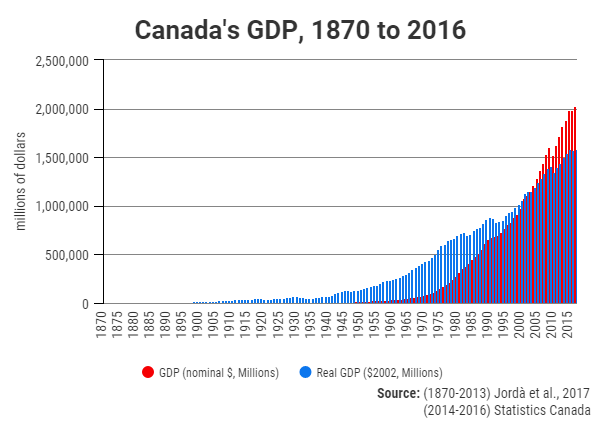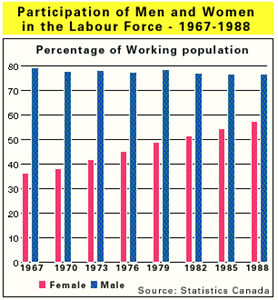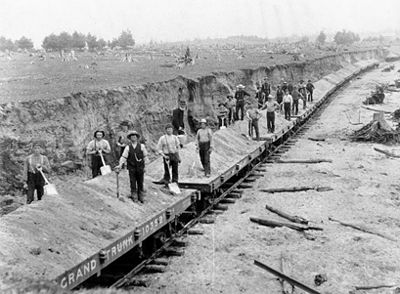“Business cycle” is a term that describes the rise and fall of economies over time. A business cycle has four parts. First, it grows. Second, it reaches its highest point. Then, it gets smaller. Finally, it reaches a low point. This cycle is called the boom-and-bust cycle. The cycle often happens over a seven-year period. No one can know exactly when the boom or bust will happen, but some experts still make predictions. It is important to do that because it helps consumers, investors and other people in the business world make decisions.
This article is a plain-language summary of Business Cycles in Canada. If you are interested in reading about this topic in more depth, please see our full-length entry, Business Cycles in Canada.
Stages of the Business Cycle
The business cycle is measured by calculating the change in the gross domestic product (GDP). The GDP is the total value of goods and services that are produced over time. The GDP is measured monthly, quarterly (four times a year) and yearly. The GDP is measured to judge the health of an economy and the stage it is at on the business cycle. The business cycle can also be calculated by measuring the production of industries, as well as the rate of employment. That means the percentage of people who have jobs. (See also Labour Force.)
People who measure business cycles use graphs. Wave patterns are usually the main patterns that can be seen on these graphs. The rise of the graph represents the rise of the economy. We know that the economy is rising when more goods and services are created than before. The economy cannot rise forever, though. The reason for this is that goods and services are finite. The word “finite” means having limits. When economies rise, consumers want to buy more goods and services because they have more money than before. So, prices rise because there is a limited amount of goods and services. When this happens, consumers buy less goods and services. This results in less goods and services being produced because those who produce the goods and services cannot make as large a profit as they did before. The GDP then declines. This part of the business cycle is called a “contraction,” meaning getting smaller. The business cycle then repeats.
Usually, the time that an economy rises is longer than the time that an economy contracts. That said, all economies at one time or another experience recessions. A recession is when the GDP falls for two quarters in a row (six months). Sometimes the GDP falls for a longer period of time. This period is called a depression. A depression is rare. In healthy economies, GDP rises over time.
Canada, like all other countries, goes through the business cycle. And like all other countries, it has experienced economic depressions. The worst depression began in 1929 (see Great Depression in Canada (Plain-Language Summary). It lasted for a very long time. Following the Second World War, however, the Canadian economy expanded greatly. And, in general terms, it is still continuing to expand.
The Government and the Business Cycle
Governments can play a big role in affecting the business cycle. They do so because they want to make the economic challenges that Canadians face during economic downturns easier. They can affect the business cycle in a few ways. For instance, governments may stop spending as much or spend more. (See also Fiscal Policy.)They can also change interest rates. (See also Monetary Policy.) This has a big effect on the amount of money that people can borrow. When interest rates are high, people borrow less. They then spend less. This can help to deflate economic bubbles. If economic bubbles become too big, they can cause serious recessions or even depressions.
Although governments in democratic countries like Canada can and do play a role in the business cycle, they cannot stop it. The business cycle is a product of the economy.

 Share on Facebook
Share on Facebook Share on X
Share on X Share by Email
Share by Email Share on Google Classroom
Share on Google Classroom









